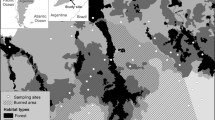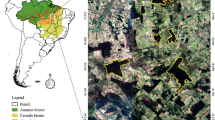Abstract
This study evaluates biotic responses, using ants as bio-indicators, to relatively recent anthropogenic disturbances to mature forest in central Amazonia. The structure of the ground-foraging ant community was compared in four habitats that represented a gradient of disturbance associated with differences in land use. Ants were collected in undisturbed, mature forest, in an abandoned pasture, in a young regrowth forest (situated in a former pasture area), and in an old regrowth forest (established where mature forest was just cleared and abandoned). More ant species were found in mature and old regrowth forest than in the abandoned pasture. By contrast, ant abundance tended to decrease with forest maturity. Both pasture and young regrowth forest exhibited a distinct ant species composition compared to mature forest, whereas species composition in the old regrowth forest showed greater similarity to that of mature forest. In spite of differences in fallow time between former pasture areas and non-pasture areas, there is evidence that different land-management practices do result in different rates of recovery of the ant forest fauna after land abandonment. In any case, recuperation of the ground-foraging ant fauna appears to be faster than regeneration of the woody-plant community. In this sense, regrowth forests may be valuable for the conservation of ground-foraging ants and perhaps for other components of mature-forest leaf-litter fauna within the context of a fragmented landscape.
Similar content being viewed by others
References
Alvarado, A., Berish, C.W. and Peralta, F. (1981) Leaf-cutter ant (Atta cephalotes) influence on the— morphology of andepts in Costa Rica. J. Soil Sci. 45, 790–4.
Andersen, A.N. (1990) The use of ant communities to evaluate change in Australian terrestrial ecosystems: a review and a recipe. Proc. Ecol. Soc. Aust. 16, 347–57.
Belbin, L. (1995) PATN User's Guide. Canberra: CSIRO Division of Wildlife and Ecology.
Belshaw, R. and Bolton, B. (1993) The effect of forest disturbance on the leaf litter ant fauna in Ghana. Biodiv. Conserv. 2, 656–66.
Bestelmeyer, B.T. and Wiens, J.A. (1996) The effects of land use on the structure of ground-foraging ant communities in the Argentine chaco. Ecol. Appl. 6, 1225–40.
Bierregaard, R.O. Jr, Lovejoy, T.E., Kapos, V., Santos, A.A. and Hutchings, R.W. (1992) The biological dynamics of tropical rainforest fragments. BioScience 42, 859–66.
Bolton, B. (1994) Identification Guide to the Ant Genera of the World. Cambridge, MA: Harvard University Press.
Bray, J.R. and Curtis, J.T. (1957) An ordination of the upland forest communities of southern Wisconsin. Ecol. Monogr. 27, 325–49.
Carroll, C.R. and Risch, S.J. (1984) The dynamics of seed harvesting in early successional com-munities by a tropical ant, Solenopsis geminata. Oecologia 61, 388–92.
Didhan, R. (1997) The influence of edge effects and forest fragmentation on leaf litter invertebrates in central Amazonia. In Tropical Forest Remnants: ecology, management and conservation of fragmented communities (W.F. Laurance and R.O. Bierregaard Jr, eds) pp. 55–70. Chicago: University of Chicago Press.
Fittkau, E.J. and Klinge, H. (1973) On biomass and tropic structure of the Central Amazonian rain forest ecosystem. Biotropica 5, 2–14.
Haines, B.L. (1978) Element and energy flows through colonies of the leaf-cutting ant, Atta col-ombica, in Panama. Biotropica 10, 270–7.
Horvitz, C.C. and Beattie, A.J. (1980) Ant dispersal of Calathea (Marantaceae) seeds by carnivorous ponerines (Formicidae) in a tropical rain forest. Am. J. Bot. 67, 321–6.
Lugo, A.E. (1988) Estimating reductions in the diversity of tropical forest species. In BioDiversity (E.O. Wilson, ed.) pp. 58–70. Washington, DC: National Academy Press.
Lugo, A.E., Farnworth, E.G., Poole, D., Jerez, P. and Kaufman, G. (1973) The impact of the leaf-cutter and Atta colombica on the energy flow of a tropical wet forest. Ecology 54, 1292–301.
MacKay, W.P., Rebeles, A., Arredondo, H.C., Rodriguez, A.Z., Gonzales, D.A. and Vinson, S.B. (1991) Impact of the slash and burning of a tropical rain forest on the native ant fauna (Hymenoptera: Formicidae). Sociobiology 18, 257–68.
Majer, J.D. (1983) Ants: bio-indicators of minesite rehabilitation, land-use and land conservation. Environ. Manag. 7, 375–83.
Moutinho, P.R.S. (1998) Impactos do uso da terra sobre a fauna de formigas: consequêzncias para a recuperação florestal na Amazônia Oriental. In Floresta Amazônica: dinâmica, recuperação e manejo (C. Gascon and P.R.S. Moutinho, eds) pp. 155–170. Manaus, Brazil: Instituto Nacional de Pesquisas da Amazô nia.
Myers, N. (1988) Tropical forests and their species: going, going...? In BioDiversity (E.O. Wilson, eds) pp. 28–35. Washington, DC: National Academy Press.
Nepstad, D., Uhl, C. and Serrão, E. (1990) Surmounting barriers to forest regeneration in aban-doned, highly degraded pastures: A case study from Paragominas, Para, Brazil. In Alternatives to Deforestation, steps Toward Sustaniable Use of the Amazon Rain Forest (A. Anderson, ed.) pp. 215–29. New York: Columbia University Press.
Nepstad, D.C., Jipp, P., Moutinho, P., Negreiros, G. and Vieira, S. (1995) Forest recovery following pasture abandonment in Amazonia: canopy seasonality, fire resistance and ants. In Evaluating and Monitoring the Health of Large-scale Ecosystems (D.J. Rapport, C.L. Gaudet and P. Calow, eds) pp. 333–49. Berlin: Springer-Verlag.
Oliver, I. and Beattie, A.J. (1996) Designing a cost-effective invertebrate survey: a test of methods for rapid assessment of biodiversity. Ecol. Appl. 6, 594–607.
Petal, J. (1978) The role of ants in ecosystems. In Production Ecology of Ants and Termites (M.V. Brian, ed.) pp. 293–325. Cambridge: Cambridge University Press.
Ribeiro, M.N.G. (1976) Aspectos climatolôgicos de Manaus. Acta Amazonica 6, 229–33.
Risch, S.J. and Carroll, C.R. (1982) The ecological role of ants in two Mexican agroecosystems. Oecologia 55, 114–9.
Roth, D.S., Perfecto, I. and Rathcke, B. (1994) The effects of management systems on ground-foraging ant diversity in Costa Rica. Ecol. Appl. 4, 423–36.
Stouffer, P.C. and Bierregaard, R.O., Jr (1995) Use of Amazonian forest fragments by understory insectivorous birds. Ecology 76, 2429–45.
Uhl, C. (1987) Factors controlling succession following slash-and-burn agriculture in Amazonia. J. Ecol. 75, 377–407.
Uhl, C., Nepstad, D., Buschbacher, R., Clark, K., Kauffman, B. and Subler, S. (1990) Studies of ecosystem response to natural and anthropogenic disturbances provide gudelines for designing sustainable land-use systems in Amazonia. In Alternatives to Deforestation, Steps Toward Sustainable Use of the Amazon Rain Forest (A. Anderson, ed.) pp. 24–42. New York: Columbia University Press.
Vasconcelos, H.L. (1991) Mutualism between Maieta guianesis Aubl., a myrmecophytic melastome, and one of its ant inhabitants: ant protection against insect herbivores. Oecologia 87, 295–8.
Vasconcelos, H.L. and Cherrett, J.M. (1995) Changes in leaf-cutting ant populations (Formicidae: Attini) after the clearing of mature forest in Brazilian Amazonia. Studies Neotrop. Fauna Environ. 30, 107–13.
Vasconcelos, H.L., Carvalho, K.S. and Delabie, J.H.C. (1998) Ecology and conservation of a fragmented forest: some perspectives based on studies of ground ant communities. In The Ecology and Conservation of a Fragmented Forest: lessons from Amazonia (R.O. Bierregaard Jr, C. Gascon, T.E. Lovejoy and A.A. Santos, eds). Yale University Press (in press).
Vasconcelos, H.L. and Delabie, J.H.C. (1998) A study of forest fragmentation near Manaus, Brazil. In Measuring and Monitoring Biodiversity: standard methods for ground-dwelling ants (D. Agosti, J. Majer, T. Schultz and L. Tennant, eds). Washington, DC: Smithsonian Institution Press (in press).
Vieira, R.S. and Höfer, H. (1994) Prey spectrum of two army ant species in central Amazonia, with special attention on their effect on spider populations. Andrias 13, 189–98.
Wilson, E.O. (1987) The arboreal ant fauna of Peruvian Amazon forests: a first assessment. Biotropica 19, 245–51.
Author information
Authors and Affiliations
Rights and permissions
About this article
Cite this article
Vasconcelos, H.L. Effects of forest disturbance on the structure of ground-foraging ant communities in central Amazonia. Biodiversity and Conservation 8, 407–418 (1999). https://doi.org/10.1023/A:1008891710230
Issue Date:
DOI: https://doi.org/10.1023/A:1008891710230




